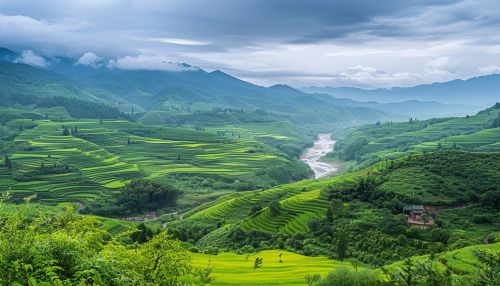Sichuan
Geography
Sichuan, located in the upper reach of the Yangtze River and the hinterland of Southwest China, is known for its unique geographical features. The eastern part of the province is primarily composed of hill-like elevations and the Sichuan Basin, while the west is characterized by numerous mountain ranges forming the eastern edge of the Tibetan Plateau. This geographical dichotomy has a significant impact on the climate, biodiversity, and lifestyle of the inhabitants.


Climate
Sichuan has a monsoon-influenced humid subtropical climate, with milder winters and hotter, more humid summers in the eastern basin. The western mountainous regions, due to their higher elevations, experience a colder, alpine climate. The region is often cloudy, and receives less annual sunshine hours than other parts of China.
History
Sichuan, rich in history, has been inhabited since the Neolithic Age. The region was known as the State of Shu before it was conquered by the Qin Dynasty in 316 BC. The region's history is marked by periods of independence and invasions by outside forces. During the Tang Dynasty, Sichuan was a significant economic and cultural center. The region was devastated by the An-Shi Rebellion, but was able to recover under the Song Dynasty.
Economy
Sichuan's economy is one of the most important in China. The province is rich in mineral resources, with significant reserves of coal, natural gas, and vanadium. The eastern part of Sichuan, being flat and fertile, is also one of China's leading agricultural production bases. The western mountainous areas, rich in biodiversity, have significant potential for tourism development. Sichuan is also a major industrial base, with industries such as electronics, IT, heavy equipment manufacturing, food, and automobile production playing significant roles.
Culture
Sichuan is known for its rich and unique culture. The Sichuan Opera, a type of Chinese opera featuring unique elements such as face-changing, fire-spitting, and acrobatics, is a cultural symbol of the region. Sichuan cuisine, known for its bold flavors and use of chili peppers and garlic, is one of the Eight Great Traditions of Chinese cuisine. The province is also home to the Giant Panda, a symbol of China and a key species in global conservation efforts.
Demographics
Sichuan is the fourth most populous province in China, with a population predominantly composed of the Han Chinese. The province is also home to numerous ethnic minorities, including the Yi, Tibetan, and Qiang peoples. The official language is Mandarin, although the Sichuan dialect, known as Sichuanese, is widely spoken.
Education
Sichuan has a well-developed education system with numerous prestigious universities and institutions. The Sichuan University and the Southwest Jiaotong University are among the most renowned. The province also has a high literacy rate, with a strong emphasis on education in both urban and rural areas.
